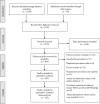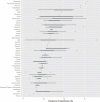Prevalence of Hypertension in Low- and Middle-Income Countries: A Systematic Review and Meta-Analysis
- PMID: 26683910
- PMCID: PMC5058882
- DOI: 10.1097/MD.0000000000001959
Prevalence of Hypertension in Low- and Middle-Income Countries: A Systematic Review and Meta-Analysis
Abstract
We aimed to obtain overall and regional estimates of hypertension prevalence, and to examine the pattern of this disease condition across different socio-demographic characteristics in low-and middle-income countries. We searched electronic databases from inception to August 2015. We included population-based studies that reported hypertension prevalence using the current definition of blood pressure ≥140/90 mm Hg or self-reported use of antihypertensive medication. We used random-effects meta-analyses to pool prevalence estimates of hypertension, overall, by World Bank region and country income group. Meta-regression analyses were performed to explore sources of heterogeneity across the included studies. A total of 242 studies, comprising data on 1,494,609 adults from 45 countries, met our inclusion criteria. The overall prevalence of hypertension was 32.3% (95% confidence interval [CI] 29.4-35.3), with the Latin America and Caribbean region reporting the highest estimates (39.1%, 95% CI 33.1-45.2). Pooled prevalence estimate was also highest across upper middle income countries (37.8%, 95% CI 35.0-40.6) and lowest across low-income countries (23.1%, 95% CI 20.1-26.2). Prevalence estimates were significantly higher in the elderly (≥65 years) compared with younger adults (<65 years) overall and across the geographical regions; however, there was no significant sex-difference in hypertension prevalence (31.9% vs 30.8%, P = 0.6). Persons without formal education (49.0% vs 24.9%, P < 0.00001), overweight/obese (46.4% vs 26.3%, P < 0.00001), and urban settlers (32.7% vs 25.2%, P = 0.0005) were also more likely to be hypertensive, compared with those who were educated, normal weight, and rural settlers respectively. This study provides contemporary and up-to-date estimates that reflect the significant burden of hypertension in low- and middle-income countries, as well as evidence that hypertension remains a major public health issue across the various socio-demographic subgroups. On average, about 1 in 3 adults in the developing world is hypertensive. The findings of this study will be useful for the design of hypertension screening and treatment programmes in low- and middle-income countries.
Conflict of interest statement
The authors have no conflicts of interest to disclose.
Figures






References
-
- Mathers C, Stevens G, Mascarenhas M. Global Health Risks: Mortality and Burden of Disease Attributable to Selected Major Risks. Geneva: World Health Organization; 2009.
-
- World Heart Federation. 2015. Cardiovascular disease risk factors. [online] Available at: http://www.world-heart-federation.org/cardiovascular-health/cardiovascul...(Accessed 18/05/2015).
-
- World Health Organization. 2015. Top ten causes of death. [online] Available at: http://www.who.int/mediacentre/factsheets/fs310/en/(Accessed 17/05/2015).
-
- Kearney PM, Whelton M, Reynolds K, et al. Global burden of hypertension: analysis of worldwide data. Lancet 2005; 365:217–223. - PubMed
-
- Picon RV, Fuchs FD, Moreira LB, et al. Prevalence of hypertension among elderly persons in urban Brazil: a systematic review with meta-analysis. Am J Hypertens 2013; 26:541–548. - PubMed
Publication types
MeSH terms
LinkOut - more resources
Full Text Sources
Medical
Molecular Biology Databases
Miscellaneous

